

Experiencing Galápagos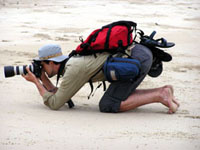
Going to
Galápagos is coming close to a pilgrimage for biologists and is
fulfilling a lifetime dream of many others. "Going to Galápagos"
conveys associations about the sailboat Beagle anchored in shallow
waters and of Darwin exploring the nearby shore, about giant turtles,
tame birds, sea lions, and large flocks of ancient looking marine
iguanas lining black lava cliffs.
With
this in mind we get our first sight of the islands from the airplane
lowering down to a small runaway on the sparsely vegetated Baltra
Island. Passengers get off the plane to walk the 100 meters or so from
the plane to what is called a terminal at the former US military
airport.
People line up where inspectors from the National Park scan
through luggage to prevent the import of fruits and animals. This is
comforting because we heard about the problems with introduced plants
and animals that are transported from the continent intentionally or
involuntarily. 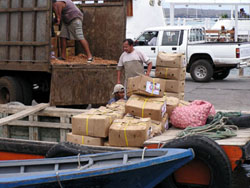 Once established, they often
outcompete native species. But the luggage scan
also stirr a premonition - ahead of us lie not only stories of pristine
nature and about Darwin's trip but the modern reality of these islands.
Since the local human population on Galápagos has been growing
rapidly, conservation issues have become increasingly pressing and
conflicting interests repeatedly sparked confrontations between local
politicians and fishermen on the one hand and the National Park Service
personnel and international NGOs on the other hand.
Once established, they often
outcompete native species. But the luggage scan
also stirr a premonition - ahead of us lie not only stories of pristine
nature and about Darwin's trip but the modern reality of these islands.
Since the local human population on Galápagos has been growing
rapidly, conservation issues have become increasingly pressing and
conflicting interests repeatedly sparked confrontations between local
politicians and fishermen on the one hand and the National Park Service
personnel and international NGOs on the other hand.
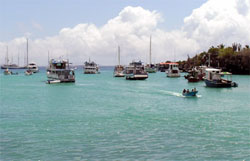 Most
foreign visitors quickly pass the controls in the small airport hall
and after a short bus ride they embark on a Yacht. A crew aboard is
ready to provide the "adventure of a lifetime", as the internet
presentation of a touring company promises. Tourists are supposed to
indulge in the natural wonders of the last paradise on earth, and not
to worry about problems during their trip, as one can everywhere else
in the
word. After all, people leave a lot of money to get a glimpse of this
paradise.
Most
foreign visitors quickly pass the controls in the small airport hall
and after a short bus ride they embark on a Yacht. A crew aboard is
ready to provide the "adventure of a lifetime", as the internet
presentation of a touring company promises. Tourists are supposed to
indulge in the natural wonders of the last paradise on earth, and not
to worry about problems during their trip, as one can everywhere else
in the
word. After all, people leave a lot of money to get a glimpse of this
paradise.
We join the
local crowd of Galágenos headed for the channel of Itabaca,
where a ferry brings us to the endpoint of a road passing the main
island of St. Cruz from North to South through the misty highlands of
wood-covered volcanoes. One and a half hours later the bus arrives in
the midsts of Puerto Ayora, a town of over ten thousand.
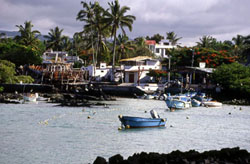 In 1959, scientists from the Max Planck Society
recommended
a place at Academy Bay on St. Cruz for the establishment of the Charles
Darwin
Research Station to expolre the life history of the Galápagos.
At the
same time, the newly founded National Park authority was assigned with
conservation of the delicate nature in the archipelago. In the
early sixties, the first offical vessel started to host tourists. From
the beginning on, tourism was restricted to guided
groups aboard a limited number of registered vessels on which visitors
live and from where they undertake short trips to the most attractive
sites. With rising numbers of tourists and immigrants from the
continent, the formerly small and tranquil place at Academy Bay was
getting a more and
more town-like appearance.
In 1959, scientists from the Max Planck Society
recommended
a place at Academy Bay on St. Cruz for the establishment of the Charles
Darwin
Research Station to expolre the life history of the Galápagos.
At the
same time, the newly founded National Park authority was assigned with
conservation of the delicate nature in the archipelago. In the
early sixties, the first offical vessel started to host tourists. From
the beginning on, tourism was restricted to guided
groups aboard a limited number of registered vessels on which visitors
live and from where they undertake short trips to the most attractive
sites. With rising numbers of tourists and immigrants from the
continent, the formerly small and tranquil place at Academy Bay was
getting a more and
more town-like appearance.
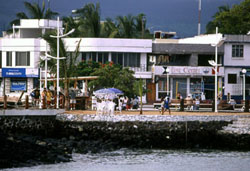 The way how tourists travel by boat is helping to avoid
the involuntary transport of alien plant and animal species from one
island
to another. People eat and sleep on board and enter islands with no
more
than a light daypack. The group sizes are limited and a trained Naional
Park guide accompanies each vessel. In contrast, when scientists
venture out in the archipelago, they usually don't travel as much
between
islands, but spend extended
times at remote places and have to bring along everything necessary.
This involves the danger of transporting potentially disastrous
invertebrates and plant seeds or pathogens. For example introduced
fire-ants, which are very aggressive against the native fauna are of
major concern. They are tiny and easily overlooked in boxes full of
provisioning, which is of course very attractive to them. A protocol
had been designed to minimize the danger of tranporting animals, seeds,
or pathogens between the islands. Before we leave the main island St.
Cruz, we meticulously have to treat
food and equipment. Fresh food is excluded, with the exception of
onions,
garlic, potatos, and carrots. All have to be pealed and washed before
being stored for transport. Other than that, our provisions are
composed of canned food, rice, noodles, and cereals. Any package of dry
food could harbor small insects and has to be frozen to kill stowaways.
The way how tourists travel by boat is helping to avoid
the involuntary transport of alien plant and animal species from one
island
to another. People eat and sleep on board and enter islands with no
more
than a light daypack. The group sizes are limited and a trained Naional
Park guide accompanies each vessel. In contrast, when scientists
venture out in the archipelago, they usually don't travel as much
between
islands, but spend extended
times at remote places and have to bring along everything necessary.
This involves the danger of transporting potentially disastrous
invertebrates and plant seeds or pathogens. For example introduced
fire-ants, which are very aggressive against the native fauna are of
major concern. They are tiny and easily overlooked in boxes full of
provisioning, which is of course very attractive to them. A protocol
had been designed to minimize the danger of tranporting animals, seeds,
or pathogens between the islands. Before we leave the main island St.
Cruz, we meticulously have to treat
food and equipment. Fresh food is excluded, with the exception of
onions,
garlic, potatos, and carrots. All have to be pealed and washed before
being stored for transport. Other than that, our provisions are
composed of canned food, rice, noodles, and cereals. Any package of dry
food could harbor small insects and has to be frozen to kill stowaways.
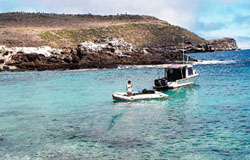 Our group of six lays out plans for a trip to the
uninhabited island of St. Fé. We join forces to clean and peel
three kilograms of onions and prepare further food to be taken along to
the island. All is finally packed in containers and loaded on board the
"fiebra" that will carry us and our makeshift camp household for the
following three weeks to St. Fé.
Our group of six lays out plans for a trip to the
uninhabited island of St. Fé. We join forces to clean and peel
three kilograms of onions and prepare further food to be taken along to
the island. All is finally packed in containers and loaded on board the
"fiebra" that will carry us and our makeshift camp household for the
following three weeks to St. Fé.
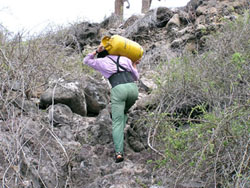 We enjoy a fabulous passage with a big sperm whale
crossing
in front or our boat. This was the more comfortable part of the move,
what lies ahead is the drudgery of unloading all our equipment in
shallow water and bringing it up a rocky cliff. But soon we are being
rewarded. The plateau with the designated camp site offers a marvelous
view over an azure sea. Tents are erected and tarps are spun out over
bamboo poles for protectoin against the elements.
We enjoy a fabulous passage with a big sperm whale
crossing
in front or our boat. This was the more comfortable part of the move,
what lies ahead is the drudgery of unloading all our equipment in
shallow water and bringing it up a rocky cliff. But soon we are being
rewarded. The plateau with the designated camp site offers a marvelous
view over an azure sea. Tents are erected and tarps are spun out over
bamboo poles for protectoin against the elements.
A first visitor
shows up and is inspecting fearlessly our equipment. The land iguana
that calls the surroundings of our camp his home is very curious and
used to the idea to host a group of scientists once a year.
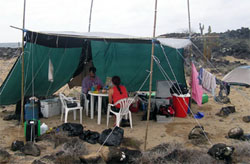 Soon we have a little zoo in and
around our camp with the rice rats eager to lick some overlooked soup
spill on our gas stove, a short-toed owl hunting the rice rats and
grasshoppers while
walking in and around our
kitchen. Our "wild pets" are amazingly tame and curious, once the owl
even landed on Silke's shoulder where a big grasshopper got lost.
Soon we have a little zoo in and
around our camp with the rice rats eager to lick some overlooked soup
spill on our gas stove, a short-toed owl hunting the rice rats and
grasshoppers while
walking in and around our
kitchen. Our "wild pets" are amazingly tame and curious, once the owl
even landed on Silke's shoulder where a big grasshopper got lost. 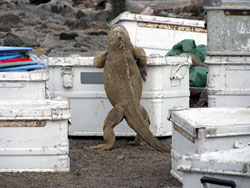 For us, this intimacy means double efforts to assure that
all food and waste is secured in closed boxes and containers. But not
enough, for want of food, rice rats chew all kinds of rubber and
plastic, destroying things that become most valuable to us, like the
pipe of
our water filter. For the lack of replacements, every single item
becomes increasingly important for our daily needs. A
plastic bottle with cooking oil can become a
real treasure on this place, if it's the last one. Even more painful,
when it's the rubber
of your
binocular's eyepieces, which the rats picked out.
For us, this intimacy means double efforts to assure that
all food and waste is secured in closed boxes and containers. But not
enough, for want of food, rice rats chew all kinds of rubber and
plastic, destroying things that become most valuable to us, like the
pipe of
our water filter. For the lack of replacements, every single item
becomes increasingly important for our daily needs. A
plastic bottle with cooking oil can become a
real treasure on this place, if it's the last one. Even more painful,
when it's the rubber
of your
binocular's eyepieces, which the rats picked out.
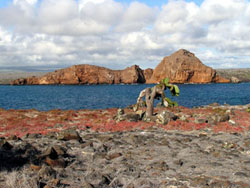 Other fellows, like the sea lion youngsters, welcome us
and obviously want to play while we wash our dishes on the beach or
ourselves in the sea. You get
used to personal hygiene with salt water, while fresh water is being
reserved for cooking and drinking. Some people may have problems
accepting such basic conditions for the daily needs. But after all, we
soon fall in love with the view from our "sanitary corner". While
comfortably leaning against a laval rock five meters above the surf
looking over an azure horizon towered by red-billed tropicbirds and
elegant fregatbirds - it definitely offers the most amazing scenery I
ever enjoyed from a restroom.
Other fellows, like the sea lion youngsters, welcome us
and obviously want to play while we wash our dishes on the beach or
ourselves in the sea. You get
used to personal hygiene with salt water, while fresh water is being
reserved for cooking and drinking. Some people may have problems
accepting such basic conditions for the daily needs. But after all, we
soon fall in love with the view from our "sanitary corner". While
comfortably leaning against a laval rock five meters above the surf
looking over an azure horizon towered by red-billed tropicbirds and
elegant fregatbirds - it definitely offers the most amazing scenery I
ever enjoyed from a restroom.


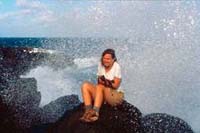
 Once established, they often
outcompete native species. But the luggage scan
also stirr a premonition - ahead of us lie not only stories of pristine
nature and about Darwin's trip but the modern reality of these islands.
Since the local human population on Galápagos has been growing
rapidly, conservation issues have become increasingly pressing and
conflicting interests repeatedly sparked confrontations between local
politicians and fishermen on the one hand and the National Park Service
personnel and international NGOs on the other hand.
Once established, they often
outcompete native species. But the luggage scan
also stirr a premonition - ahead of us lie not only stories of pristine
nature and about Darwin's trip but the modern reality of these islands.
Since the local human population on Galápagos has been growing
rapidly, conservation issues have become increasingly pressing and
conflicting interests repeatedly sparked confrontations between local
politicians and fishermen on the one hand and the National Park Service
personnel and international NGOs on the other hand.  Most
foreign visitors quickly pass the controls in the small airport hall
and after a short bus ride they embark on a Yacht. A crew aboard is
ready to provide the "adventure of a lifetime", as the internet
presentation of a touring company promises. Tourists are supposed to
indulge in the natural wonders of the last paradise on earth, and not
to worry about problems during their trip, as one can everywhere else
in the
word. After all, people leave a lot of money to get a glimpse of this
paradise.
Most
foreign visitors quickly pass the controls in the small airport hall
and after a short bus ride they embark on a Yacht. A crew aboard is
ready to provide the "adventure of a lifetime", as the internet
presentation of a touring company promises. Tourists are supposed to
indulge in the natural wonders of the last paradise on earth, and not
to worry about problems during their trip, as one can everywhere else
in the
word. After all, people leave a lot of money to get a glimpse of this
paradise.  In 1959, scientists from the Max Planck Society
recommended
a place at Academy Bay on St. Cruz for the establishment of the Charles
Darwin
Research Station to expolre the life history of the Galápagos.
At the
same time, the newly founded National Park authority was assigned with
conservation of the delicate nature in the archipelago. In the
early sixties, the first offical vessel started to host tourists. From
the beginning on, tourism was restricted to guided
groups aboard a limited number of registered vessels on which visitors
live and from where they undertake short trips to the most attractive
sites. With rising numbers of tourists and immigrants from the
continent, the formerly small and tranquil place at Academy Bay was
getting a more and
more town-like appearance.
In 1959, scientists from the Max Planck Society
recommended
a place at Academy Bay on St. Cruz for the establishment of the Charles
Darwin
Research Station to expolre the life history of the Galápagos.
At the
same time, the newly founded National Park authority was assigned with
conservation of the delicate nature in the archipelago. In the
early sixties, the first offical vessel started to host tourists. From
the beginning on, tourism was restricted to guided
groups aboard a limited number of registered vessels on which visitors
live and from where they undertake short trips to the most attractive
sites. With rising numbers of tourists and immigrants from the
continent, the formerly small and tranquil place at Academy Bay was
getting a more and
more town-like appearance. The way how tourists travel by boat is helping to avoid
the involuntary transport of alien plant and animal species from one
island
to another. People eat and sleep on board and enter islands with no
more
than a light daypack. The group sizes are limited and a trained Naional
Park guide accompanies each vessel. In contrast, when scientists
venture out in the archipelago, they usually don't travel as much
between
islands, but spend extended
times at remote places and have to bring along everything necessary.
This involves the danger of transporting potentially disastrous
invertebrates and plant seeds or pathogens. For example introduced
fire-ants, which are very aggressive against the native fauna are of
major concern. They are tiny and easily overlooked in boxes full of
provisioning, which is of course very attractive to them. A protocol
had been designed to minimize the danger of tranporting animals, seeds,
or pathogens between the islands. Before we leave the main island St.
Cruz, we meticulously have to treat
food and equipment. Fresh food is excluded, with the exception of
onions,
garlic, potatos, and carrots. All have to be pealed and washed before
being stored for transport. Other than that, our provisions are
composed of canned food, rice, noodles, and cereals. Any package of dry
food could harbor small insects and has to be frozen to kill stowaways.
The way how tourists travel by boat is helping to avoid
the involuntary transport of alien plant and animal species from one
island
to another. People eat and sleep on board and enter islands with no
more
than a light daypack. The group sizes are limited and a trained Naional
Park guide accompanies each vessel. In contrast, when scientists
venture out in the archipelago, they usually don't travel as much
between
islands, but spend extended
times at remote places and have to bring along everything necessary.
This involves the danger of transporting potentially disastrous
invertebrates and plant seeds or pathogens. For example introduced
fire-ants, which are very aggressive against the native fauna are of
major concern. They are tiny and easily overlooked in boxes full of
provisioning, which is of course very attractive to them. A protocol
had been designed to minimize the danger of tranporting animals, seeds,
or pathogens between the islands. Before we leave the main island St.
Cruz, we meticulously have to treat
food and equipment. Fresh food is excluded, with the exception of
onions,
garlic, potatos, and carrots. All have to be pealed and washed before
being stored for transport. Other than that, our provisions are
composed of canned food, rice, noodles, and cereals. Any package of dry
food could harbor small insects and has to be frozen to kill stowaways. Our group of six lays out plans for a trip to the
uninhabited island of St. Fé. We join forces to clean and peel
three kilograms of onions and prepare further food to be taken along to
the island. All is finally packed in containers and loaded on board the
"fiebra" that will carry us and our makeshift camp household for the
following three weeks to St. Fé.
Our group of six lays out plans for a trip to the
uninhabited island of St. Fé. We join forces to clean and peel
three kilograms of onions and prepare further food to be taken along to
the island. All is finally packed in containers and loaded on board the
"fiebra" that will carry us and our makeshift camp household for the
following three weeks to St. Fé. We enjoy a fabulous passage with a big sperm whale
crossing
in front or our boat. This was the more comfortable part of the move,
what lies ahead is the drudgery of unloading all our equipment in
shallow water and bringing it up a rocky cliff. But soon we are being
rewarded. The plateau with the designated camp site offers a marvelous
view over an azure sea. Tents are erected and tarps are spun out over
bamboo poles for protectoin against the elements.
We enjoy a fabulous passage with a big sperm whale
crossing
in front or our boat. This was the more comfortable part of the move,
what lies ahead is the drudgery of unloading all our equipment in
shallow water and bringing it up a rocky cliff. But soon we are being
rewarded. The plateau with the designated camp site offers a marvelous
view over an azure sea. Tents are erected and tarps are spun out over
bamboo poles for protectoin against the elements.  Soon we have a little zoo in and
around our camp with the rice rats eager to lick some overlooked soup
spill on our gas stove, a short-toed owl hunting the rice rats and
grasshoppers while
walking in and around our
kitchen. Our "wild pets" are amazingly tame and curious, once the owl
even landed on Silke's shoulder where a big grasshopper got lost.
Soon we have a little zoo in and
around our camp with the rice rats eager to lick some overlooked soup
spill on our gas stove, a short-toed owl hunting the rice rats and
grasshoppers while
walking in and around our
kitchen. Our "wild pets" are amazingly tame and curious, once the owl
even landed on Silke's shoulder where a big grasshopper got lost.  For us, this intimacy means double efforts to assure that
all food and waste is secured in closed boxes and containers. But not
enough, for want of food, rice rats chew all kinds of rubber and
plastic, destroying things that become most valuable to us, like the
pipe of
our water filter. For the lack of replacements, every single item
becomes increasingly important for our daily needs. A
plastic bottle with cooking oil can become a
real treasure on this place, if it's the last one. Even more painful,
when it's the rubber
of your
binocular's eyepieces, which the rats picked out.
For us, this intimacy means double efforts to assure that
all food and waste is secured in closed boxes and containers. But not
enough, for want of food, rice rats chew all kinds of rubber and
plastic, destroying things that become most valuable to us, like the
pipe of
our water filter. For the lack of replacements, every single item
becomes increasingly important for our daily needs. A
plastic bottle with cooking oil can become a
real treasure on this place, if it's the last one. Even more painful,
when it's the rubber
of your
binocular's eyepieces, which the rats picked out.  Other fellows, like the sea lion youngsters, welcome us
and obviously want to play while we wash our dishes on the beach or
ourselves in the sea. You get
used to personal hygiene with salt water, while fresh water is being
reserved for cooking and drinking. Some people may have problems
accepting such basic conditions for the daily needs. But after all, we
soon fall in love with the view from our "sanitary corner". While
comfortably leaning against a laval rock five meters above the surf
looking over an azure horizon towered by red-billed tropicbirds and
elegant fregatbirds - it definitely offers the most amazing scenery I
ever enjoyed from a restroom.
Other fellows, like the sea lion youngsters, welcome us
and obviously want to play while we wash our dishes on the beach or
ourselves in the sea. You get
used to personal hygiene with salt water, while fresh water is being
reserved for cooking and drinking. Some people may have problems
accepting such basic conditions for the daily needs. But after all, we
soon fall in love with the view from our "sanitary corner". While
comfortably leaning against a laval rock five meters above the surf
looking over an azure horizon towered by red-billed tropicbirds and
elegant fregatbirds - it definitely offers the most amazing scenery I
ever enjoyed from a restroom.